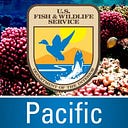World’s Oldest Known, Banded Wild Bird Hatches Chick at Midway Atoll
Wisdom, a mōlī (Laysan albatross) and world’s oldest known, banded wild bird, hatched a new chick this week at Midway Atoll. Biologists first observed the egg pipping on Friday, January 29. After several days, the chick hatched on Monday, February 1.
Every year, millions of albatrosses return to Midway Atoll National Wildlife Refuge and Battle of Midway National Memorial. Beginning in October, birds return to their same nesting site and reunite with their mate in the world’s largest colony of albatrosses. Wisdom and her mate, Akeakamai, have been hatching and raising chicks together since at least 2012, when biologists first banded Akeakamai.
“At least 70 years old, we believe Wisdom has had other mates,” said U.S. Fish and Wildlife Service biologist Dr. Beth Flint. “Though albatross mate for life, they may find new partners if necessary — for example if they outlive their first mate.”
Albatross don’t typically lay eggs every year and when they do, they lay only one egg. Each chick that makes it to adulthood makes a difference to for the future of the albatross population. Biologists estimate that Wisdom has hatched at least 30–36 chicks in her lifetime. In 2018, biologists observed the chick that she fledged in 2011 just a few feet away from her current nest. Countless generations of albatrosses on Midway Atoll have a similar family reunion each year.
The incubation period after an albatross lays an egg is typically 65 days — most chicks on Midway Atoll hatch in January or February. Wisdom laid her egg sometime during the last few days of November. Soon after, Wisdom returned to sea to forage and her mate Akeakamai took over incubation duties. Albatross parents share incubation duties and once the chick hatches, share feeding duties. Parents feed their chicks a diet rich in fish eggs and squid by regurgitating the food they forage while at sea into the waiting mouths of their hungry chicks. The fatty acids and nutrients can sustain a chick for a number of days between feedings. Chicks fledge, fly for the first time, in the months of June and July.
Nearly 70% of the world’s mōlī and almost 40% of kaʻupu (black-footed albatross), as well as endangered makalena (short-tailed albatross) all rely on Midway Atoll. In addition to albatrosses, more than 20 other bird species breed at Midway Atoll, most of them tropical seabirds. In total, over three million individual birds call the Refuge and Memorial home.
Throughout the Monument, scientific research and monitoring plays an essential role in managing wildlife, including seabirds. Surveys and banding projects conducted in the Monument and throughout the world help scientists better understand the life cycles and migration patterns of birds. Biologists first identified and banded Wisdom in 1956, but the very first albatross was banded on Midway Atoll in 1936. To date over 275,000 albatrosses have been banded at the Refuge and Memorial. By pairing modern data analysis with detailed current and historical records, biologists can make more informed management decisions that ensure seabirds have the habitat and resources they need in the future.
“Each year that Wisdom returns, we learn more about how long seabirds can live and raise chicks,” said Flint. “Her return not only inspires bird lovers everywhere, but helps us better understand how we can protect these graceful seabirds and the habitat they need to survive into the future.”
Biologists and volunteers are working to restore the habitat seabirds need at Midway Atoll and remove threats like invasive predators — because protecting the future for seabirds mean protecting the places they call home.
Located on the far northern end of the Hawaiian archipelago, Midway Atoll Refuge and Memorial is managed by the U.S. Fish and Wildlife Service and lies within the Papahānaumokuākea Marine National Monument. It is one the oldest atoll formations in the world, provides nesting habitat for millions of seabirds, and is a touchstone for one of the most significant naval battles of World War II, and in history, the Battle of Midway. To learn more about Midway Atoll: https://www.fws.gov/refuge/midway_Atoll/
Papahānaumokuākea is cooperatively managed to ensure ecological integrity and achieve strong, long-term protection and perpetuation of Northwestern Hawaiian Island ecosystems, Native Hawaiian culture, and heritage resources for current and future generations. Four co-trustees — the Department of Commerce, Department of the Interior, State of Hawai‘i and the Office of Hawaiian Affairs — protect this special place. Papahānaumokuākea Marine National Monument was inscribed as the first mixed (natural and cultural) UNESCO World Heritage Site in the United States in July 2010. For more information, please visit www.papahanaumokuakea.gov.
The U.S. Fish and Wildlife Service works with others to conserve, protect, and enhance fish, wildlife, plants, and their habitats for the continuing benefit of the American people. For more information, connect with us through any of these social media channels at https://www.facebook.com/PacificIslandsFWS, www.flickr.com/photos/usfwspacific/, or www.twitter.com/USFWSPacific.

